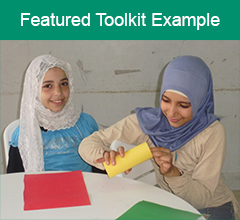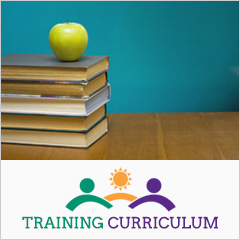This toolkit aids in assessing and enhancing cultural competence in your organization or community effort.
- Define Your Vision and Goals for Cultural Competence
- Indicate what cultural competence would look like and the related goals for your organization or community.
- Describe the vision for cultural competence - What qualities your organization or community would have when it becomes more culturally competent. These vision statements might include:
- People of diverse backgrounds and experience working together.
- People understanding and appreciating one another's differences.
- People being respectful of those different from them.
What is your organization or community's vision for cultural competence?
- For each relevant level indicate the goal for cultural competence:
- Individual level - increase respectful engagement by yourself or other members
- Organizational level - change policy and practices to enhance inclusion and respectful engagement with different groups.
- Program level - redesign programs or intervention so that they are more effective and a better fit with cultural beliefs and practices.
- Community level - increase respectful engagement among those from diverse cultures and decrease intolerant practices by community members.
What will your goal for cultural competence be at the:
Individual level:
Organizational level:
Program level:
Community level:
Related resources:
Proclaiming Your Dream: Developing Vision and Mission Statements
Building Culturally Competent Organizations
- Describe the vision for cultural competence - What qualities your organization or community would have when it becomes more culturally competent. These vision statements might include:
- Indicate what cultural competence would look like and the related goals for your organization or community.
- Conduct a Cultural Audit
- Describe the cultural context of your organization or community
- Identify the different cultures or shared experiences represented in the organization, group, and community in which you belong or work. These may include groups that differ in: (fill in those that are appropriate for your organization or group)
- Nationality
- Ethnicity
- Native language
- Race
- Gender
- Religion or spiritual beliefs
- Occupational Status
- Educational Status
- Economic status or social class
- Physical attributes
- Relationship Status
- Age group
- Geographical/regional residency
- Health status
- Others specific to a group
- Identify the current expectations and stereotypes in your group or community about people from each of these cultures, and how these stereotypes might affect communication and your ability to work together. Examples of stereotypes, which can be positive, negative, or neutral, may include:
- Hardworking or lazy
- Family-oriented or work-focused
- Withholding or generous
- Expressive or quiet
- Suspicious of strangers, unfriendly, or open and warm
- Aggressive or gentle
- Emotional or unfeeling
- Traditional or open to change
- Intelligent or ignorant
List those cultural groups within your community or organization and the possible stereotypes that affect how you communicate or work with them:
- Identify the different cultures or shared experiences represented in the organization, group, and community in which you belong or work. These may include groups that differ in: (fill in those that are appropriate for your organization or group)
- Characterize the current relationships among cultures within your organization, group, or community:
- What cultures are represented in your organization currently? which ones are excluded?
- What kinds of relationships are already established among cultural groups?
- How well are different cultural groups well organized?
- What kinds of conflicts or struggles currently exist among cultural groups? What historical events set the stage for the current conflict?
- How well are conflicts between groups openly recognized and talked about?
- Over which issues in the community have different cultural groups historically worked together to make improvements?
- Have there been or are there efforts to strengthen alliances among groups?
- What values and concerns do different cultural groups have in common?
- Assess the level of knowledge, attitudes, and behaviors related to cultural competence of those in your organization or community:
- Knowledge of the characteristics, experiences, beliefs, values, and norms of the cultural group(s) of interest.
- Respect for these cultural elements without assumptions of superiority or inferiority.
- Behavioral skills for working with people from different cultures.
- Presence of supportive relationships within the culture, and among with whom you are working and in your own culture.
- The state of curiosity, appreciation of your limited knowledge, and a commitment to learn about others.
- Awareness of how your own culture and experiences have shaped how you see others.
- Identify possible difficulties (or opportunities) you or your organization may encounter due to cultural differences. Describe how differences in the varied aspects listed will affect your ability to understand and work effectively with diverse cultural groups:
- Communication styles
- Language usage (e.g., formal, street language).
- Non-verbal communication (e.g., eye contact, gestures).
- Assertiveness expressed.
What difficulties (or opportunities) may your group encounter due to different communication styles?
- Attitudes toward conflict
- Positive or negative.
- Face-to-face or less direct methods of resolution.
What difficulties (or opportunities) may your group encounter due to different conflict styles?
- Approaches to completing tasks
- Orientation toward task (e.g., focus on getting things done).
- Orientation towards relationships (e.g., focus on how people are feeling).
What difficulties (or opportunities) may your group encounter due to different task completion styles?
- Decision-making styles
- Delegation or tightly held decision-making powers.
- Consensus, majority rule or other forms of group involvement.
What difficulties (or opportunities) may your group encounter due to different decision-making styles?
- Attitudes about open emotional and personal matters
- Variations in comfort level in disclosure (e.g., willingness to talk about self or relationships).
- Need for privacy or preference for openness.
- Inclusion of emotion or personal issues in decisions.
What difficulties (or opportunities) may your group encounter due to different disclosure styles?
- Approaches to knowing
- Analytical (head, thinking) or intuitive (heart, feeling).
- Statistics, facts and science; or symbols, stores, and spirit.
What difficulties (or opportunities) may your group encounter due to different approaches to knowing?
- Communication styles
- Assess the level of cultural competence (i.e., ability to respectfully engage those from different cultures or backgrounds) of your organization or community. Consider the current practice or ability to:
- Be involved and comfortable with people from different cultures and backgrounds.
- Show genuine respect for others who are different.
- Work effectively with people from different cultures and backgrounds.
- Link to networks of people and groups from different cultures and backgrounds.
Related resources:
Understanding and Describing the Community
Understanding Culture and Diversity in Building Community
Healing from the Effects of Internalized Oppression
Building Culturally Competent Organizations
- Describe the cultural context of your organization or community
- Build a Culturally Competent Organization
- Based on the cultural audit or assessment, identify goals for enhancing the cultural competence of your organization. For each goal (see potential goals below) indicate what "success" would look like if the goal were attained:
- Proclaiming Your Dream: Developing Vision and Mission Statements
- Increase people's involvement and comfort with those from different cultures and backgrounds.
- Enhance the respect people show for others who are different.
- Increase members' effectiveness in working with people from different cultures and backgrounds.
- Increase links to networks of people and groups from different cultures and backgrounds.
- Develop and enforce policies that assure everyone's safety and rights regardless of cultural aspect or background.
- For each stated goal at the individual level (e.g., individual members of the group), identify specific activities that will be done to achieve success. These may include:
- Putting yourself and others in situations where you will meet people from other cultures and backgrounds.
- Examining your biases about people from other cultures (e.g., listing stereotypes and opinions you have of groups and the origins of those biases).
- Asking people questions about their cultures, customs and views, and comparing them to your own.
- Reading about other people's cultures and histories.
- Listening to people tell their stories to better appreciate their experiences.
- Noting differences in what people value and do, in order to better understand how practices different from your own can be as or more effective in certain situations.
- Helping teach and encourage others to experience and appreciate different ways of seeing doing things.
- For each stated goal at the organizational level (e.g., overall organization), identify specific activities that will be done to achieve success. Activities may include:
- Including expectations for cultural competence in job descriptions.
- Ensuring your organizational facility is accessible and respectful of difference in it physical appearance, lay-out, decorations, and location.
- Engaging local people and other experts to teach and model cultural competence.
- Working together with people of other cultures in your community to reach common goals.
- Actively eliminating prejudice and discrimination in policies and practices
- Adapting policies and practices within the organization to assure safety, equal rights, and respect for all regardless of culture or backgrounds.
- For each stated goal at the program level, identify specific activities that will be done to achieve success. Activities may include:
- Reviewing how the organization's programs, policies, and practices incorporate and accommodate local values and customs.
- Modifying current programs or interventions to better reflect the local customs and values of those affected by the organization's actions.
- Redesigning proposed activities with the assistance of people from multiple cultures in order to assure their relevance and increase their effectiveness.
- For each activity aimed at reaching goals at the organizational and program level, indicate:
- Who will complete the activity
- What will they do
- By when
- With what resources
- In communication with whom
- Review your organization's progress in meeting your goals for becoming culturally competent. Evaluate the organization's level of cultural competence and make needed adjustments.
Are you satisfied with the organization's progress? What adjustments might improve your success?
Related resources:
Understanding Culture and Diversity in Building Community
Building Culturally Competent Organizations
Building Relationships with People from Different Cultures
Creating Opportunities for Members of Groups to Identify Their Similarities, Differences, and Assets
Multicultural Collaboration
Developing Personnel Policies
Creating Objectives
Preparing Job Descriptions and Selection Criteria
Understanding Culture, Social Organization, and Leadership to Enhance Engagement
Involving Key Influentials in the Initiative
- Based on the cultural audit or assessment, identify goals for enhancing the cultural competence of your organization. For each goal (see potential goals below) indicate what "success" would look like if the goal were attained:
- Build a Culturally Inclusive Community
- Imagine a culturally inclusive community. Depending on your situation, success might look like:
- All citizens are engaged in decision that affect their lives.
- People take a stand when groups are targeted with unjust treatment.
- Public policies correct inequalities in the system (e.g., unequal educational opportunities).
- There are bridges and social ties among people from different cultures, backgrounds, and communities.
What would success look like for cultural inclusiveness in your community?
- Assess the cultural inclusiveness of the community as a whole, if you have not already done so in your cultural audit.
- What cultural groups exist in the community?
- How do these groups function? Consider the interaction of their leaders, their social structure, where they live, what languages they speak, their cultural "rules", their methods of decision-making, and their social, political, and religious gathering places
- How are particular groups seen by the rest of the community?
- Is there, or has there ever been, discrimination?
- What's the community's history, including the history of different cultural groups in the community, their relationship with greater community, and their history with each other?
- Invite opinion leaders and others from all groups to join in creating a vision of inclusiveness for the whole community
- Purposely seek out and invite representatives of many cultural groups to join your efforts to create an inclusive community.
- Many people from different cultural groups should be involved from the very beginning in order to promote equal partnership and ownership in the process.
- Once the group has formed, choose leaders and methods of functioning that build consensus among the members.
Who should be at the table or represented?
- Identify a substantive issue from which to build inclusiveness
- What is the most important issue in your community that affects people of all cultural backgrounds?
- Identify a common issue that can help bring people of different cultures together to work towards a common purpose
What substantive issues may help bring people from different cultural groups together in your community?
- Develop a strategic plan for using that issue to build inclusiveness within a participatory process
- Describe long-range goals related to the creation of an inclusive community (e.g., engage all citizens in decision making).
- Describe short-range goals (e.g., development of intergroup relationships, addressing shared issues).
- Describe how you will assess or evaluate progress reaching those goals.
- Encourage group members to establish relationships outside the group. Indicate how you will do so including by:
- Arranging for culturally diverse groups of people to carry out specific projects together.
- Regular discussions of common ground and similar concerns at public meetings.
- Participation in events and celebrations of different cultures.
- Rotating groups meetings among communities of the cultures represented in the broader community.
- Establishing regular social occasions outside the group.
- Actively create a welcoming atmosphere for those outside the group.
Describe ways your organization might encourage individual relationships among members.
- Identify the assets that each cultural group brings to the table, and use those assets in strategic planning. For example:
- Skills related to visual arts, music, craftsmanship.
- Experience in political action.
- Expertise in conflict resolution.
- Other assets.
- Identify, respect, and transform conflicts into improved capacity and relationships in the community. Set ground rules for resolving conflict among members and with the community at the beginning of the effort.
What ground rules for resolving conflict would be important to establish for your organization?
- Ensure institutional or systemic support for promoting social inclusion and equity. Indicate how you will accomplish this through:
- Involving representatives from key institutions to participate in the effort from the very beginning.
- Convincing potential supporters that including marginalized groups is in their best interest economically.
- Advocating to those with influence through the political power of various cultural groups.
How will your organization ensure institutional or systemic support for your goals in your community?
- Acknowledge and celebrate successful collaborative action
- Use the opportunity to promote the benefits of working together.
- Make the celebration itself multicultural.
Describe how you will celebrate future successful action in order to promote inclusion.
- Evaluate your effort to promote cultural inclusion at regular intervals, making needed adjustments
- Evaluate those actions related to accomplishing the group's short and long term goals and those actions related to the process itself.
Describe how your efforts to promote cultural inclusion have been successful.
Describe how you might make adjustments to better reach short and long term goals.
Related resources:
Proclaiming Your Dream: Developing Vision and Mission Statements
Building Inclusive Communities
Understanding and Describing the Community
Understanding Culture and Diversity in Building Community
Promoting Participation Among Diverse Groups
Multicultural Collaboration
Developing an Action Plan
Building Relationships with People from Different Cultures
Transforming Conflicts in Diverse Communities
Rewarding Accomplishments
A Framework for Program Evaluation: A Gateway to Tools
- Evaluate those actions related to accomplishing the group's short and long term goals and those actions related to the process itself.
- Imagine a culturally inclusive community. Depending on your situation, success might look like:







